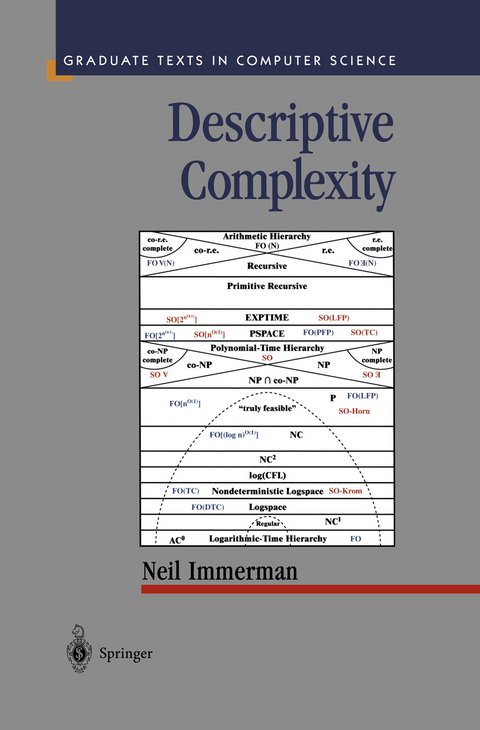
Descriptive Complexity
Springer-Verlag New York Inc.
978-0-387-98600-5 (ISBN)
1 Background in Logic.- 1.1 Introduction and Preliminary Definitions.- 1.2 Ordering and Arithmetic.- 1.3 Isomorphism.- 1.4 First-Order Queries.- 2 Background in Complexity.- 2.1 Introduction.- 2.2 Preliminary Definitions.- 2.3 Reductions and Complete Problems.- 2.4 Alternation.- 2.5 Simultaneous Resource Classes.- 2.6 Summary.- 3 First-Order Reductions.- 3.1 FO ? L.- 3.2 Dual of a First-Order Query.- 3.3 Complete problems for L and NL.- 3.4 Complete Problems for P.- 4 Inductive Definitions.- 4.1 Least Fixed Point.- 4.2 The Depth of Inductive Definitions.- 4.3 Iterating First-Order Formulas.- 5 Parallelism.- 5.1 Concurrent Random Access Machines.- 5.2 Inductive Depth Equals Parallel Time.- 5.3 Number of Variables Versus Number of Processors.- 5.4 Circuit Complexity.- 5.5 Alternating Complexity.- 6 Ehrenfeucht-Fraïssé Games.- 6.1 Definition of the Games.- 6.2 Methodology for First-Order Expressibility.- 6.3 First-Order Properties Are Local.- 6.4 Bounded Variable Languages.- 6.5 Zero-One Laws.- 6.6 Ehrenfeucht-Fraïssé Games with Ordering.- 7 Second-Order Logic and Fagin’s Theorem.- 7.1 Second-Order Logic.- 7.2 Proof of Fagin’s Theorem.- 7.3 NP-Complete Problems.- 7.4 The Polynomial-Time Hierarchy.- 8 Second-Order Lower Bounds.- 8.1 Second-Order Games.- 8.2 SO?(monadic) Lower Bound on Reachability.- 8.3 Lower Bounds Including Ordering.- 9 Complementation and Transitive Closure.- 9.1 Normal Form Theorem for FO(LFP).- 9.2 Transitive Closure Operators.- 9.3 Normal Form for FO(TC).- 9.4 Logspace is Primitive Recursive.- 9.5 NSPACE[s(n)] = co-NSPACE[s(n)].- 9.6 Restrictions of SO.- 10 Polynomial Space.- 10.1 Complete Problems for PSPACE.- 10.2 Partial Fixed Points.- 10.3 DSPACE[nk] = VAR[k + 1].- 10.4 Using Second-Order Logic to Capture PSPACE.- 11 Uniformity andPrecompulation.- 11.1 An Unbounded Number of Variables.- 11.2 First-Order Projections.- 11.3 Help Bits.- 11.4 Generalized Quantifiers.- 12 The Role of Ordering.- 12.1 Using Logic to Characterize Graphs.- 12.2 Characterizing Graphs Using Lk.- 12.3 Adding Counting to First-Order Logic.- 12.4 Pebble Games for Ck.- 12.5 Vertex Refinement Corresponds to C2.- 12.6 Abiteboul-Vianu and Otto Theorems.- 12.7 Toward a Language for Order-Independent P.- 13 Lower Bounds.- 13.1 Håstad’s Switching Lemma.- 13.2 A Lower Bound for REACHa.- 13.3 Lower Bound for Fixed Point and Counting.- 14 Applications.- 14.1 Databases.- 14.2 Dynamic Complexity.- 14.3 Model Checking.- 14.4 Summary.- 15 Conclusions and Future Directions.- 15.1 Languages That Capture Complexity Classes.- 15.2 Why Is Finite Model Theory Appropriate?.- 15.3 Deep Mathematical Problems: P versus NP.- 15.4 Toward Proving Lower Bounds.- 15.5 Applications of Descriptive Complexity.- 15.6 Software Crisis and Opportunity.- References.
| Reihe/Serie | Texts in Computer Science |
|---|---|
| Zusatzinfo | XVI, 268 p. |
| Verlagsort | New York, NY |
| Sprache | englisch |
| Maße | 155 x 235 mm |
| Themenwelt | Mathematik / Informatik ► Informatik ► Netzwerke |
| Mathematik / Informatik ► Informatik ► Theorie / Studium | |
| Mathematik / Informatik ► Mathematik ► Logik / Mengenlehre | |
| ISBN-10 | 0-387-98600-6 / 0387986006 |
| ISBN-13 | 978-0-387-98600-5 / 9780387986005 |
| Zustand | Neuware |
| Haben Sie eine Frage zum Produkt? |
aus dem Bereich


